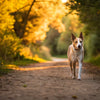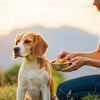How Long to Wait to Exercise Your Dog After Eating: A Guide for Responsible Pet Owners
- Houndsy
Table of Contents
- Introduction
- The Canine Digestive Process
- The Risks of Exercising After Eating
- How Long Should You Wait?
- Benefits of Post-Meal Walks
- Establishing a Feeding and Exercise Routine
- Consulting Your Veterinarian
- Conclusion
- FAQs
Introduction
As dog parents, we often find ourselves navigating a myriad of questions about our furry friends' health and well-being. One particularly pressing concern is the timing of exercise in relation to feeding. Have you ever wondered how long to wait to exercise your dog after eating? According to veterinary experts, it’s not just a matter of preference; it can significantly impact your dog’s health and comfort.
Statistics reveal that gastric dilatation-volvulus (GDV), commonly known as bloat, is a serious condition that can affect dogs, especially large breeds, after meals. Understanding the right timing for exercise can help prevent such health risks and ensure your dog enjoys a happy, healthy life. In this blog post, we’ll delve deep into the topic, exploring the effects of exercise on digestion, the risks associated with immediate post-meal activity, and practical tips for establishing an optimal feeding and walking routine for your dog.
By the end of this post, you’ll have a clear understanding of how long to wait before exercising your dog after eating, as well as insights into managing their feeding schedule effectively. So, let’s get started on this essential aspect of pet care!
The Canine Digestive Process
To fully appreciate the importance of timing when it comes to feeding and exercise, it’s critical to understand how a dog’s digestive system works. When your dog eats, food travels from the mouth down the esophagus into the stomach, where it is mixed with gastric juices and broken down into a semi-liquid state. This mixture then moves into the small intestine for nutrient absorption, a process that can take several hours to complete.
- Digestion Duration: Generally, food takes anywhere from 6 to 10 hours to digest in a dog’s system, depending on various factors like breed, age, and diet type. Large meals may take longer to digest than smaller ones.
Understanding this process helps us realize why exercising immediately after eating can lead to complications. Just like humans, dogs need time for their bodies to process and break down food before engaging in physical activities.
The Risks of Exercising After Eating
Exercising your dog too soon after a meal poses several health risks. The two most prominent concerns are bloating and GDV, both of which can have severe consequences.
Bloating and GDV
Bloating occurs when the stomach fills with gas, which can cause discomfort and pain. In more severe cases, it can lead to GDV, a life-threatening condition where the stomach twists and obstructs blood flow. Some key points about GDV include:
- High-Risk Breeds: Larger breeds, especially those with deep chests like Great Danes, Boxers, and German Shepherds, are more susceptible to GDV.
- Symptoms of GDV: Common signs include restlessness, pacing, excessive drooling, swelling of the abdomen, and lethargy. If you notice any of these symptoms in your dog, seek veterinary assistance immediately.
Other Risks of Immediate Exercise
In addition to bloating and GDV, exercising after eating can lead to:
- Digestive Disturbance: Engaging in vigorous activity can inhibit proper digestion, cause cramps, and result in vomiting.
- Reduced Blood Flow to the Digestive Tract: During exercise, blood flow is redirected to the muscles, which can interrupt the digestive process.
Given these risks, it’s essential to establish a safe routine that promotes your dog’s health and comfort.
How Long Should You Wait?
Veterinarians typically recommend the following waiting periods before exercising your dog after meals:
- 30 Minutes: After a small snack.
- 1 Hour: After a small or medium meal.
- 2 to 3 Hours: After a large meal.
This guidance helps minimize the risk of bloating and ensures that your dog’s digestive system has adequate time to start processing the food.
Factors to Consider
While the above guidelines are generally applicable, individual circumstances may vary based on:
- Breed: Larger breeds may require longer waiting times compared to smaller breeds.
- Age: Puppies and older dogs may have different digestive capabilities and thus different exercise needs.
- Health Status: Dogs with pre-existing health conditions may need tailored advice from a veterinarian.
Benefits of Post-Meal Walks
While it’s crucial to avoid vigorous exercise immediately after meals, light activity, such as a gentle walk, can actually aid digestion. Here are some benefits of post-meal walks:
- Stimulates Digestion: A leisurely stroll can help stimulate the digestive system, making it easier for your dog to process food.
- Promotes Regularity: Walking helps maintain regular bowel movements, which can prevent constipation.
- Calming Routine: Establishing a routine that includes post-meal walks can help your dog relax and feel more settled after eating.
Timing Matters
When planning your post-meal walks, consider starting with a short, calm walk about 30 minutes to an hour after a smaller meal. For larger meals, wait at least two hours before heading out.
Establishing a Feeding and Exercise Routine
To create a healthy routine for your dog, consider the following tips:
- Schedule Consistent Meal Times: Feeding your dog at the same times each day helps regulate their digestive system and makes it easier to plan walks.
- Monitor Portion Sizes: Adjust the size of meals based on your dog’s activity level and size. Smaller, more frequent meals can reduce the risk of bloating.
- Incorporate Light Activity: Engage in light play or short walks after meals, gradually increasing the intensity as appropriate.
Consulting Your Veterinarian
Ultimately, every dog is unique. If you have concerns about your dog’s health or how their feeding and exercise routines might affect them, consulting your veterinarian is always a wise choice. They can provide personalized recommendations based on your dog’s specific needs.
Conclusion
Understanding how long to wait to exercise your dog after eating is crucial for their health and comfort. By allowing adequate time for digestion, you can significantly reduce the risk of bloating and GDV, ensuring your furry friend remains happy and healthy. Remember to consider factors like your dog’s breed, age, and health status when planning their feeding and exercise routines.
As we prioritize our dogs’ well-being, let’s also think about how we can enhance their feeding experience. At Houndsy, we are dedicated to elevating the dog-feeding ritual with our innovative Houndsy Kibble Dispenser. Designed with mid-century modern aesthetics and functionality, it ensures perfect portion control and complements your home decor beautifully. Explore the Houndsy Kibble Dispenser here to make feeding your dog a delightful and convenient experience.
FAQs
How long should I wait after feeding my dog before exercising?
It’s generally recommended to wait at least 30 minutes after a small snack, 1 hour after a small or medium meal, and 2 to 3 hours after a large meal before exercising your dog.
What are the signs of bloat in dogs?
Signs of bloat may include restlessness, pacing, excessive drooling, swelling of the abdomen, and lethargy. If you notice these symptoms, seek veterinary care immediately.
Can I walk my dog after eating?
Yes, you can take a gentle walk after your dog has eaten, but it's important to wait at least 30 minutes to an hour, depending on the size of the meal.
What should I do if my dog exercises after eating?
If your dog exercises right after eating, monitor them closely for any signs of discomfort, bloating, or distress. If you notice any concerning symptoms, consult your veterinarian.
How can I prevent GDV in my dog?
To reduce the risk of GDV, avoid feeding large meals before exercise, opt for smaller, more frequent meals, and allow your dog to rest after eating.












